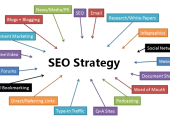If you’re running an e-commerce business, you already know that success requires more than a great product. You need to get your product in front of potential customers, and one of the best ways to do that is through link building. E-commerce link building involves getting other websites to link back to your e-commerce site, which can help improve your search engine rankings and drive more traffic.
Link building for e-commerce can be challenging but essential to any successful online marketing strategy. Link building can help you establish your brand, increase visibility, and drive more sales. However, it’s important to remember that not all links are equal. It would be best to build high-quality links from reputable sources relevant to your business. This means you’ll need to invest time and effort into researching and reaching out to potential link partners.

Understanding E-Commerce Link Building
If you’re running an e-commerce website, you’re probably already aware of the importance of search engine optimization (SEO) and its role in driving traffic to your site. One of the most important aspects of SEO is link building, which involves getting other websites to link back to your site. In this section, we’ll explore the importance of backlinks for e-commerce and how link building can improve your SEO and traffic.
The Importance of Backlinks for E-Commerce
Backlinks are links from other websites to your site. They are essential for e-commerce because they signal to search engines like Google that your site is reputable and authoritative. The more high-quality backlinks you have, the higher your site will rank in search engine results pages (SERPs).
Backlinks are like votes of confidence from other websites. The more votes you have, the more trustworthy you appear to be. In the world of e-commerce, where trust is essential, having a lot of high-quality backlinks can make a big difference in your success.

How Link Building Improves SEO and Traffic
Link building is the process of acquiring backlinks to your site. Many ways exist, including guest blogging, broken link building, and creating high-quality content people want to link to.
Link building can improve your SEO and traffic in several ways. First, as mentioned earlier, backlinks signal to search engines that your site is reputable and authoritative. This can lead to higher rankings in SERPs, translating to more site traffic.
Second, link building can help you attract referral traffic. Referral traffic comes to your site from other sites that link to you. This type of traffic can be highly targeted and convert faster than other types.
In conclusion, e-commerce link building is an essential aspect of SEO and can significantly impact your site’s success. High-quality backlinks can improve your site’s reputation, authority, and visibility in search engine results pages.
Developing a Link Building Strategy
Developing a solid link-building strategy requires planning, execution, and ongoing revision. A well-planned strategy will help you identify link opportunities, create link-worthy content, and successfully reach and pitch relevant websites. Here are some steps you can take to develop a link-building strategy for your e-commerce website.
Identifying Link Opportunities
The first step in formulating a strategy for website owners is identifying potential link opportunities. This can be done by conducting competitor analysis and researching relevant websites in your niche. You can also use Ahrefs, SEMrush, and Moz tools to identify websites linking to your competitors.
Once you have identified potential link opportunities, you should evaluate each website’s relevance, authority, and trustworthiness. You can use metrics such as Domain Authority (DA), Page Authority (PA), and Trust Flow (TF) to assess a website’s quality.
Creating Link-worthy Content
Creating high-quality content is essential for attracting links from relevant websites. You should create content assets such as blog posts, infographics, videos, and whitepapers that provide value to your target audience. Your content should be informative, engaging, and visually appealing.
To increase the chances of your content being linked, you should also optimize it for search engines. This includes using relevant keywords, optimizing meta tags, and ensuring your content is mobile-friendly.

Outreach and Pitching
Once you have identified potential link opportunities and created link-worthy content, the next step is to contact and pitch relevant websites. This involves convincing website owners, editors, and bloggers to link to your content.
To successfully reach and pitch, you should personalize your emails, explain the value of your content, and highlight its relevance to your audience. You should also follow up with your outreach emails and be persistent but polite.
In conclusion, developing a link-building strategy requires research, creativity, and persistence. By identifying link opportunities, creating link-worthy content, and successfully reaching and pitching, you can attract high-quality links to your e-commerce website and improve your search engine rankings.
Leveraging Content for Link Acquisition
Regarding e-commerce link building, producing valuable content is one of the most effective strategies. Creating content that offers value to your target audience can attract links from other websites, boost your search engine rankings, and drive more traffic. Here are some ways to leverage content for link acquisition:
Utilizing Blog Posts and Infographics
One of the most popular ways to create valuable content for link acquisition is to produce blog posts and infographics. Creating high-quality, informative blog posts and infographics relevant to your industry can attract links from other websites that find your content valuable and instructive.
Producing Guides and Listicles
Another effective way to leverage content for link acquisition is to produce guides and listicles. Guides can provide in-depth information on a specific topic, while listicles offer a quick and easy way to consume information. By creating valuable guides and listicles relevant to your industry, you can attract links from other websites that find your content valuable and informative.
Incorporating Videos and Statistics
Videos and statistics are also great ways to create valuable content for link acquisition. Videos can provide a more engaging way to consume information, while statistics can provide useful insights into your industry. By incorporating videos and statistics into your content, you can attract links from other websites that find your content valuable and informative.
In conclusion, producing valuable content is one of the most effective e-commerce link-building strategies. By utilizing blog posts, infographics, guides, listicles, videos, and statistics, you can create content that offers real value to your target audience and attracts links from other websites.

Building Relationships for Sustainable Link Building
Link building is a crucial part of any e-commerce strategy, and building relationships is a critical component of successful link building. Connecting with bloggers, journalists, influencers, and your community can create sustainable link-building opportunities that benefit both parties.
Connecting with Bloggers and Journalists
Connecting with bloggers and journalists is a great way to get your brand in front of a wider audience and build quality backlinks to your e-commerce site. You can use tools like HARO (Help a Reporter Out) or contact them directly via email or social media.
Your offering must be clear and concise when reaching out to bloggers and journalists. Ensure you understand what they’re looking for and how you can help them. Building relationships with bloggers and journalists takes time, so don’t expect immediate results. Remember that these relationships can pay off in the long run, so be patient and persistent.
Engaging with Influencers and Community
In addition to connecting with bloggers and journalists, engaging with influencers and your community can lead to quality backlinks and increased brand awareness. Influencers can help promote your brand to their followers while engaging with your community, which can help build a loyal customer base.
To engage with influencers, you can reach out to them directly or use influencer marketing platforms. When engaging with your community, you can use social media, forums, and other online communities to connect with your customers and build relationships.
When engaging with influencers and your community, being authentic and providing value is essential. Don’t just focus on promoting your brand; also on building relationships and providing helpful information. Doing so can create sustainable link-building opportunities that benefit your brand and audience.
Overall, building relationships is a critical component of sustainable link-building. Connecting with bloggers, journalists, influencers, and your community can create quality backlinks and increase brand awareness. Remember that building relationships takes time and effort, but the results can be well worth it in the long run.

Measuring Link Building Success
Measuring its success is one of the most critical aspects of any link-building campaign. To determine whether your efforts are paying off, you need to track various metrics that indicate how well your campaign is performing. Here are two essential metrics to track:
Tracking Backlink Profile and Domain Metrics
Your website’s backlink profile determines its overall search engine ranking. The more high-quality backlinks you have, the better your chances of ranking higher on search engine results pages. You can use tools like Ahrefs or SEMrush to track your backlink profile and monitor the number of high-quality links you earn over time.
In addition to tracking your backlink profile, you should also monitor your website’s domain authority. Domain authority is a metric that indicates how well your website is likely to rank on search engine results pages. The higher your domain authority, the better your chances of ranking higher on search engine results pages. You can use tools like Moz to track your domain authority and monitor changes over time.

Analyzing Traffic and Conversion Rates
Another critical metric to track is your website’s traffic and conversion rates. You can use tools like Google Analytics to track your website’s organic traffic and monitor any changes over time. If your link-building campaign is successful, you should see an increase in organic traffic to your website.
In addition to tracking your website’s traffic, you should also monitor your conversion rates. Conversion rates indicate how many website visitors are taking the desired action, such as purchasing or filling out a contact form. You can use tools like Google Analytics to track your conversion rates and monitor any changes over time.
By tracking these metrics, you can determine whether your link-building campaign is successful and make any necessary adjustments to improve your results.






